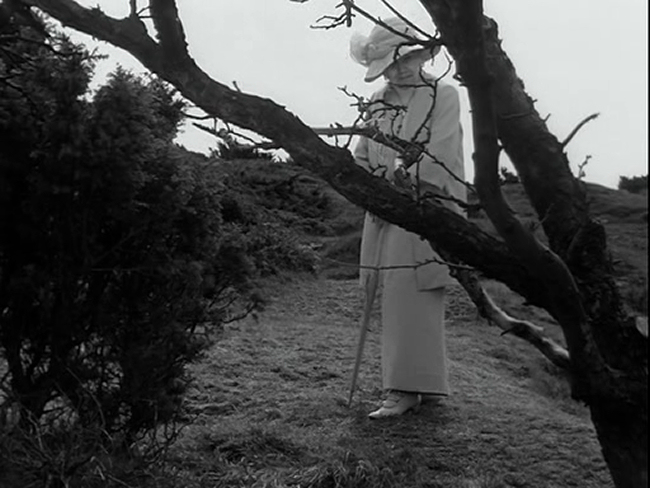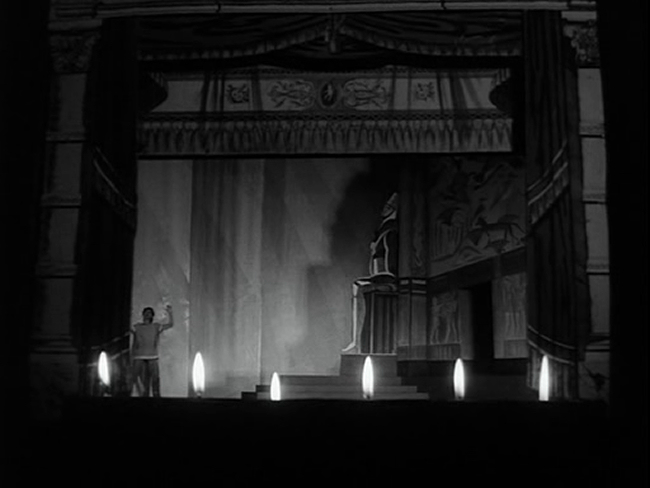
The path of damnation must be one where all things held beautiful and good are each in turn deprived of significance and wholesomeness until all things signify guilt or nothing at all. The demons that plague Johan in Ingmar Bergman's 1968 film, Hour of the Wolf (Vargtimmen) don't seem to be tempting him so much as processing him for a fate that's already been decided and are assisting him in dismantling his capacity for affection and reverence. His wife and muse, Alma, present to witness the process in horror, doesn't seem an agent assigned by God to offer him an alternative as much as someone who, through some strange chance, has ended up where she's not supposed to be. It's an eerie, frightening, and deeply sad film.
Johan (Max von Sydow) and Alma (Liv Ullmann) have taken up residence in a small house on a remote island. He's a famous painter who has fled the world due to some kind of terrible event or scandal. Alma is selflessly devoted to him and we see most of the movie from her point of view, in fact the film begins with her directly addressing the camera, recounting the events.

Bergman frequently illuminates her face more than Johan's, concealing his face in shadow and by blocking, which, together with Von Sydow's often solemn and listless performance, suggest someone who's no longer struggling against his doom. He tells Alma about the demons he encounters on the island, the eeriest among them an old woman (Naima Wifstrand) who, he says, "Is always threatening to remove her hat." The implication that something horrible will happen if she removes her hat is one of the ways the demons give the impression of an entirely superficial reality behind which there is only destruction or void.

Alma then encounters the woman with the hat and she encourages Alma to read Johan's diary. Since the diary reveals Johan's thoughts are dwelling on his former lover, Veronica (Ingrid Thulin), maybe this is one of the things that leads Alma to conclude the demons are trying to drive them apart. I never got the impression that the demons were worried Alma's love, however beautiful and compelling, would divert Johan from his path to damnation so much as they were mildly uncomfortable entertaining a guest who simply didn't belong. When Johan and Alma are invited to the demons' castle, where they're presided over by one calling himself Baron von Merkens (Erland Josephson), in their laughter and incessant mockery they seem like the catty, shallow Hollywood crowd that can't tolerate someone as sincere and ordinary as Alma.

One of the demons, Lindhorst (Georg Rydeberg), puts on a puppet show in which Bergman uses forced perspective to put a full sized actor on the tiny stage, something that reminded me of the Sultan's mechanical players in the 1940 Thief of Bagdad. In the Criterion DVD commentary for that film, Francis Ford Coppola talks about how much that image haunted him as a child and I wonder if it had the same effect on Bergman. In Hour of the Wolf, it's one of the things that make art itself seem sinister and demonic.

The demons continually endeavour to trivialise and demean art. Johan tells them he's fully aware that art isn't that important, he says the insight comes from being an artist and knowing that it's only a selfish compulsion that keeps him painting. They congratulate him on the insight and in the film's climax they go further, demeaning and mocking his reverence for the beauty of women.

A final sequence where the characters are lost in a wood is effectively horrific, as is a flashback in the middle where Johan tells Alma about an act that may have been the cause of his damnation. The former is shot in unnatural darkness and the latter with unnatural brightness, both methods stripping detail and nuance from the image, emphasising the world of hard, inflexible meaning tightening further and further around Johan.

No comments:
Post a Comment